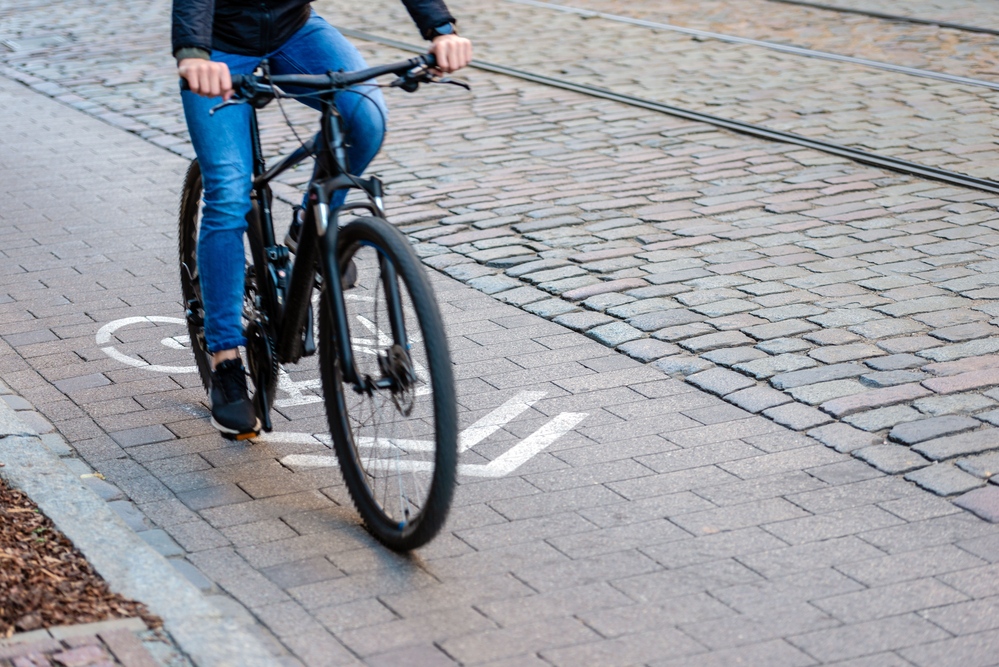Whether you’re dealing with bike lanes that share the streets with cars, or fully protected separated lanes, there are several overt and unspoken rules to be aware of when enjoying this fairly new urban infrastructure. Let’s take a look at bike lane etiquette and how you can help keep yourself and other cyclists safe while navigating the city.

Obey the rules of the road
If you’re a driver or even just use city infrastructure as a pedestrian, you probably already know the rules of the road and can simply apply them to cycling. Like cars, bicyclists should ride on the right side of the road and never against traffic. If you’re on a bike, you should observe all stop lights, traffic signs, and pedestrian walk lights. You should also signal when making a turn—and do so only when the bike lane has dashed lines and turning is allowed.
Make sure your bike is in tip-top shape
Although it is always advisable to check that your bike is in good working order before heading out, it is especially important if you’re going to use public lanes. Bike lanes can get busy and you need to consider how your behaviour is going to affect those around you. That means you want to doublecheck that your brakes work, your tyres are pumped up, and your shifters are functioning correctly. Ideally, you should also make sure you’re carrying all the tools and supplies needed to fix a flat tyre. Be mindful that you’re sharing the lane and a preventable mechanical issue has the potential to result in a crash, which ultimately might cause others in the bike lane to crash, too.

Set a positive safety example
Similarly, by following recommended safety protocol, you’ll be setting a positive example and making those around you more comfortable with sharing the lane. Adhere to best practices like wearing a helmet, dressing appropriately for the weather, making yourself visible, and having the correct lights and reflectors on your bike. Make sure you’re carrying your phone, spare cash, your ID and your insurance card. Accidents do happen and you’ll be thankful you were prepared.
Always pass with caution
Speaking of accidents, one of the best ways to avoid them is by always passing carefully and correctly. Utilize the same defensive protocol that you would when driving a car. Stay to the right if you’re a slower rider and always, always, always pass on the left. Once you’ve overtaken a slower rider and established a safe distance, move back into the right lane and repeat as necessary. In the event that you’re riding in a bike lane with only two lanes—one lane for each direction separated only by a painted line—you need to be particularly cautious. If you see someone riding your direction, err on the side of caution and simply wait for them to pass prior to making your move.

Stick to a steady, moderate pace
Bike lanes are not the place to show the world what your new carbon fibre whip can really do. Even if it isn’t busy, you should never blast down bike lanes like your KOM depends on it. Intended for everyday use, cyclists and bikes of all variety belong on bike lanes and it’s every user’s job to make others feel safe. Sure, it can be frustrating to get stuck behind a family with a trailer or a group of tourists on rented bikes, but remind yourself that every new bike on the road is a good thing for all cyclists. If the lane is clear, you can certainly go ahead and up the pace a bit, just resist the urge to go full steam ahead.
Remember that bike lanes are for everyone
Again, it is crucial to be mindful of the fact that not everyone using a bike lane will be as informed, well prepared, or aware of their surroundings as you are. Bike lanes exist to provide an available means of more sustainable and accessible transportation. What a bike means to you could be completely different for someone else. Be encouraging and friendly to other cyclists using the lane. Don’t be shy about stopping to help if you see someone struggling with a mechanical issue. You never know when you could be one requiring assistance and a little bit of good karma can go a long way.




